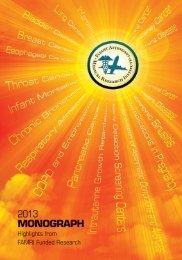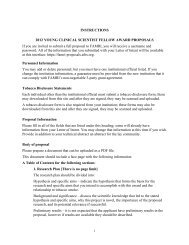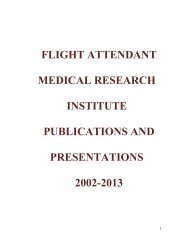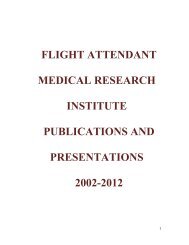MISSION
2009 compendium of FAMRI-supported research - Flight Attendant ...
2009 compendium of FAMRI-supported research - Flight Attendant ...
Create successful ePaper yourself
Turn your PDF publications into a flip-book with our unique Google optimized e-Paper software.
FAMRI Supported Publications<br />
Albers A, Abe K, Hunt J, Wang J, Lopez-Albaitero A, Schaefer C, Gooding W, Whiteside TL, Ferrone S,<br />
DeLeo A, Ferris RL. Antitumor activity of human papillomavirus type 16 E7-specific T cells against<br />
virally infected squamous cell carcinoma of the head and neck. Cancer Res 2005;65:11146-11155.<br />
Albers AE, Ferris RL, Kim GG, Chikamatsu K, DeLeo AB, Whiteside TL. Immune responses to p53 in<br />
patients with cancer: enrichment in tetramer+ p53 peptide-specific T cells and regulatory CD4+CD25+<br />
T cells at tumor sites. Cancer Immunol Immunother 2005;54:1072-1081.<br />
Kim J, Ferris RL, Whiteside TL. CCR7 protects T lymphocytes from apoptotic cell death in patients with<br />
head and neck cancer. Clin Cancer Res 2005;11:7901-7910.<br />
Kuss I, Hathaway B, Ferris RL, Gooding W, Whiteside TL. Decreased absolute counts of T lymphocyte<br />
subsets and their relation to disease in squamous cell carcinoma of the head and neck. Clin Can Res<br />
2004;10:3755-3762.<br />
Kuss I, Schaefer C, Godfrey TE, Ferris RL, Harris JM, Gooding W, Whiteside TL. Recent thymic<br />
emigrants and subsets of naive and memory T cells in the circulation of patients with head and neck<br />
cancer. Clin Immunol 2005;116:27-36.<br />
Lopez-Albaitero A, Nayak JV, Ogino T, Machandia A, Gooding W, DeLeo AB, Ferrone S, Ferris RL. Role<br />
of antigen-processing machinery in the in vitro resistance of squamous cell carcinoma of the head and<br />
neck cells to recognition by CTL. J Immunol 2006;176:3402-3409.<br />
Sirianni NM, Ha PK, Oelke M, Califano J, Gooding W, Westra W, Whiteside TL, Koch WM, Schneck JP,<br />
DeLeo A, Ferris RL. Effect of human papillomavirus-16 infection on CD8+ T cell recognition of a wild<br />
type sequence p53264-272 peptide in head and neck cancer patients. Clin Can Res 2004;10:6929-<br />
6937.<br />
PKC-EPSILON EXPRESSION ON THE OUTCOME OF CHEMOTHERAPY<br />
Lei Xiao, PhD; University of Florida; CIA 2002<br />
Dr. Xiao investigated the relationship between expression of a protein kinase C (PKC)-epsilon isoform<br />
and patient response to lung cancer chemotherapy. The difference in the regulation of PKC-epsilon expression<br />
may be important with respect to the cellular response to lung cancer chemotherapy. Results suggest<br />
that PKC-epsilon-negative lung cancer patients may have a better prognosis.<br />
ADENOVIRAL GENE TRANSFER OF FRNK AND P53 FOR TREATMENT OF HEAD AND NECK CANCER: IN VITRO<br />
STUDIES<br />
Lori J. Kornberg, PhD; University of Florida; CIA 2003<br />
Dr. Kornberg has shown that focal adhesion kinase (FAK), a tyrosine kinase that mediates intracellular<br />
signals produced by the integrin family of adhesion receptors, is overexpressed in oral and laryngeal cancers.<br />
The PI produced an epithelial line that overexpresses FAK-related non-kinase (FRNK), an FAK<br />
inhibitor, for study of these cancers. Her data suggest that expression of p53 and FRNK render cancer cells<br />
exquisitely sensitive to anticancer drugs.<br />
FAMRI Supported Publications<br />
Kornberg LJ, Villaret D, Popp M, Lu L, McLaren R, Brown H, Cohen D, Yun J, McFadden M. Gene<br />
expression profiling in squamous cell carcinoma of the oral cavity shows abnormalities in several signaling<br />
pathways. Laryngoscope 2005;115:690-698.<br />
Kornberg LJ. Adenovirus-mediated transfer of FRNK augments drug-induced cytotoxicity in cultured<br />
SCCHN cells. Anticancer Res 2005;25:4349-4356.<br />
ROLE OF EPIDERMAL GROWTH FACTOR RECEPTOR (EGFR) AND ITS DOWNSTREAM TARGETS IN HEAD AND<br />
NECK CANCERS OF SMOKING PATIENTS<br />
Alexey Fomenkov, PhD; The Johns Hopkins University; CIA 2003<br />
Dr. Fomenkov found that HNSCC from patients affected by both primary smoking and second-hand<br />
smoke exposure displayed induced tyrosine autophosphorylation of the epithelial growth factor receptor<br />
(EGFR) tyrosine and activated the phosphoinositol 3- kinase/protein kinase B (P3IK/Akt) signaling pathway.<br />
Profiling analysis of genes induced and downregulated in human tumor samples of primary smokers<br />
and those exposed to second hand tobacco revealed that the p63 gene was dramatically induced. Dr.<br />
Fomenkov showed that p63, which is a transcriptional regulator of epithelial stratification, is one of the<br />
major downstream targets of EGFR and its expression is specifically modulated by the PI3K/Akt pathway<br />
rather than by Ras/ErkIMAPK pathway. The expression pattern of ANp63a, which is a major p63 isotype<br />
P A G E 9 5







